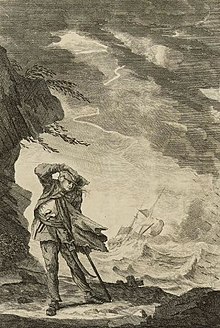



Edward "Ned" Low (also spelled Lowe or Loe; 1690–1724) was a notorious pirate of English origin during the latter days of the Golden Age of Piracy, in the early 18th century. Low was born into poverty in Westminster, London, and was a thief from an early age. He moved to Boston, Massachusetts, as a young man. His wife died in childbirth in late 1719. Two years later, he became a pirate, operating off the coasts of New England and the Azores, and in the Caribbean.
Low captained a number of ships, usually maintaining a small fleet of three or four. Low and his pirate crews captured at least a hundred ships during his short career, burning most of them. Although he was active for only three years, Low remains notorious as one of the most vicious pirates of the age, with a reputation for violently torturing his victims before murdering them.
Sir Arthur Conan Doyle described Low as "savage and desperate," and a man of "amazing and grotesque brutality". The New York Times called him a torturer, whose methods would have "done credit to the ingenuity of the Spanish Inquisition in its darkest days". The circumstances of Low's death, which took place around 1724, have been the subject of much speculation.

Capt Edward Low in ye Hurricane which He and All the Crew had Like to Perish'd by J Nicholls and James Basire, hanging in the National Maritime Museum in London
Legacy
Edward Low's acts, along with those of other pirates of the period such as Edward "Blackbeard" Teach, Bartholomew "Black Bart" Roberts, and William Fly, led to a great increase in the military presence to protect shipping lanes, resulting in the effective end of the Golden Age of Piracy.
By 1700, the European states had enough troops and ships at their disposal, following the end of a number of wars, to begin better protecting their important colonies in the West Indies and in the Americas, without relying on the aid of privateers. Pirates based in the Caribbean were chased from the seas by a new British squadron based at Port Royal, Jamaica, and a smaller group of Spanish privateers, sailing from the Spanish Main, known as the Guarda de Costa, or simply the Guarda.
Less is recorded of Low than of other equally prolific pirates such as Teach and Stede Bonnet. Howard Pyle, in an 1880 children's book on pirates, said: "No one stood higher in the trade than [Low], and no one mounted to more lofty altitudes of bloodthirsty and unscrupulous wickedness. 'Tis strange that so little has been written and sung of this man of might, for he was as worthy of story and of song as was Blackbeard". Sir Arthur Conan Doyle, in his work The Green Flag, described Low as "savage and desperate", and a man of "amazing and grotesque brutality". The New York Times said "Low and his crew became the terror of the Atlantic, and his depredations were committed on every part of the ocean, from the coast of Brazil to the Grand Banks of Newfoundland".

Artist's impression of Ned Low by Marc Davis in 1962, now on the Pirates of the Caribbean theme park ride at Disneyland
Low has featured on stamps and commemorative currency around the Caribbean. A postage stamp featuring Low was commissioned by the Cayman Islands in 1975, and in 1994 the government of Antigua and Barbuda featured Low and his brigantine, Rebecca, on a legal tender one hundred-dollar bill made of gold leaf.
"Ned Low" is one of the pirates featured on the Pirates of the Caribbean ride at the Disneyland theme park in California. A duplicate of Low's flag was used for the flag of the fictional pirate Sao Feng in Disney's Pirates of the Caribbean films. Ned Low was played by Tadhg Murphy in the Starz TV series Black Sails.
Some of Low's haunts, such as the waters around the Isles of Shoals off New Hampshire and Isle Haute in Nova Scotia, attract treasure hunters who seek artifacts in the ships he sank.

A 1936 Pac-Kups Jolly Roger Pirate card featuring an artist's impression of Edward Low
